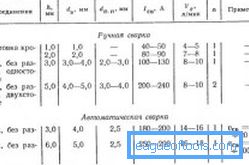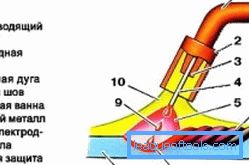How to weld stainless steel at home
Due to the fact that stainless steels have strength characteristics and are able to resist corrosion, they are quite widespread in industry and everyday life. Welding of the above material allows you to get all sorts of designs that have excellent strength characteristics, among them: railings, pipes, tanks for various purposes, etc.

Manual arc welding: 1-electrode; 2-electrode coating; 3-gas protection.
Susceptibility to material weldability
The process of welding a stainless steel is a rather difficult task, the success of which depends on a number of factors.. As the most important among them, it is possible to distinguish the ability of the metal to weldability, that is, to the formation of an interface, the weld material of which has similar or identical mechanical characteristics, as well as the metal of the main element.
This indicator is influenced by some features of the metal, which it possesses.
Thus, a high rate of linear expansion and significant linear shrinkage due to this increase the deformation of the metal at the time of welding and after the process is completed. In the presence of a large gap between the welded elements, which have a considerable thickness, huge cracks can be obtained.
Thermal conductivity, which is 1.5–2 times lower in comparison with low-carbon steels, can cause a concentration of heat and make the element melting in the interface area more significant. For this reason, at the time when stainless steel is being welded, there is a need to reduce the current by 15-20%, if we compare it with ordinary steel at the time of working on it.
Significant electrical resistance leads to excessive heating of the electrodes, which are based on high-alloy steel.

Modes when performing welding.
In order for the negative effect to be less, chromium-nickel rods, having dimensions not exceeding 350 mm, are placed at the base of the electrodes.
An important feature of stainless steel can be identified susceptibility of high-chromium steel to the loss of its anti-corrosion characteristics when using the wrong thermal conditions or improper operation of the installation for welding steel. This phenomenon is called intergranular corrosion and involves the formation of chromium and iron carbide along the edges of the grains, which subsequently act as areas of corrosion damage. Such phenomena begin to be observed at around 500 ° C and more. This can be avoided in several ways, including the immediate cooling of the weld area, for this you can even apply water cooling.
Back to table of contentsFeatures of welding
When welding a stainless steel, you need to remember its physical properties. For example, it is necessary to take into account that the specific electrical resistance is about 6 times greater, besides, 100 ° C below the melting point, the thermal conductivity is equal to 1/3 of the identical value characteristic of carbon rolled metal. The level of thermal expansion is 50% more in length.
If you have a material with a thickness greater than 1.5 mm, then at home you can perform work by the method of arc welding by means of tungsten electrodes in an inert environment. For work with pipes and thin sheets, arc welding with melting electrodes in an inert gas should be used.

The scheme of argon welding with tungsten electrodes.
If you have to work with steel, which has a thickness of 0.8 mm, then it is recommended to use pulse arc welding as a basis for the process with the help of melting electrodes in an inert gas. For cloths whose thickness is limited to 0.8-3.0 mm, the method of short arc welding should be used, where melting electrodes are used in an inert environment, whereas in the presence of sheets with a thickness exceeding 0.3 mm, it is necessary to use welding with jet transfer became melting electrodes under inert gas conditions.
The method of plasma welding is used for materials with a huge range of thickness, which allows using this technology quite often. Submerged arc welding involves the use of steels whose thickness exceeds 10 mm. But the most common way is still considered the technology of welding by means of coated electrodes, tungsten electrodes in argon. Argon semi-automatic welding is also quite popular, where it is customary to use stainless steel wire.
Welding stainless steel provides preparatory work in the area of the edges of the elements. However, this stage is not much different from the preparatory stage over the elements of low carbon steel, one exception is the exception - the welded joint must have a groove, which will guarantee free shrinkage of the seams.
Before starting work, the upper edges of the edges should be cleaned to obtain shine, a steel brush should be used, and then washed with a solvent, which can be used with aviation gasoline or acetone to remove grease.
Back to table of contentsManual welding with coated electrodes

Scheme welding semi-automatic torch.
If you decide to use steel welding by means of coated electrodes, this will allow you to get, without any special effort, good quality welds. So, if the master does not expect to get a welded joint, to which special requirements are made, then you should not look for another method of welding stainless steel.
Electrodes for manual welding should be chosen according to the characteristics that they will give to the welded joint. Among them: excellent mechanical properties, high resistance to corrosion processes and heat resistance.
Manual welding with coated electrodes is carried out by means of direct current, which has reverse polarity. In this case, it is necessary to ensure that the seam is melted as little as possible. The process is performed using electrodes with a small diameter, with the least amount of thermal energy released.
If a large current is used during operation, this can cause the elements to peel off, the reason for this is a slight thermal conductivity and an increased indicator of the electrical resistance of the electrodes. Cooling of the weld can be done by means of copper gaskets or forced air masses.
Back to table of contentsWelding by means of tungsten electrodes in argon

The scheme of the coated electrode.
If you want to get a weld that has excellent quality, then you should apply welding with tungsten electrodes in argon. For thin material, this technique fits perfectly.
In the course of work, direct or alternating current of direct polarity is used. In the role of filler material is recommended to use wire, which has a more significant indicator of doping compared with the base metal. The electrode does not need to oscillate, otherwise the protection of the cooking area may be impaired, which will lead to oxidation of the material and increase the cost of the work.
On the reverse side, the seam should be protected by argon blowing, but the stainless steel cannot be called so critical to the protection of the reverse side. It is necessary to avoid that tungsten gets into the weld pool. For this reason, it is recommended to use contactless arc ignition or to carry out these works on a graphite plate, transferring it to the main metal.
After completion of the process, it is not necessary to immediately switch off the protective gas to reduce the consumption of the tungsten electrode. This should be done after some period, it can be equal to 15 seconds. This will prevent the intense oxidation of hot electrodes and make their lifespan longer.
Back to table of contentsMechanical processing of stainless steel
When welding, use equipment designed to work with stainless steel.
Tools and materials:
- grinding belt and wheel;
- brush with metal work surface;
- solvent like aviation gasoline;
- stainless fractions.
Etching is the most effective post-processing technique for connecting joints. If this process is carried out correctly, it will be possible to eliminate the oxide layer and the region with a low chromium content. The procedure must be performed by immersion in acid, in the role of an alternative solution, you can use a paste that is usually applied from above.
A mixture of acids is often used for etching, among which is nitric and hydrofluoric, the former being used in an amount of 8–20% by volume, while the latter is used in an amount of 0.5–5%. Water is also used. Some masters for this use strong tea.
The period of the effect of the etching substance on the austenitic rolled will depend on the concentration of acid, temperature, grade of rolled products, dimensions of scale. If acid-resistant steel is used in the work, then it is subject to longer processing in comparison with stainless steel. If you make the mating roughness index to the corresponding index, characteristic of the base material, by polishing or grinding after the etching is completed, this will help to increase the resistance of the structure to corrosion phenomena.
Back to table of contentsAnalysis of the quality of welding at home
The process of welding stainless steel does not always lead to perfect quality. So, after some time after the completion of the procedure, “knife” corrosion may form in the areas of the connecting joints. In the role of exposure to elevated temperatures are hot cracks arising due to the austenitic structure of the connecting joints. They are brittle due to prolonged exposure to high temperatures and stigma.
In order to eliminate the appearance of hot cracks, it is recommended to use filler materials that allow to obtain strong seams. With the same purpose it is necessary to carry out arc welding, which implies a small arc length. No need to bring craters to the main metal.
If it was decided to use automatic welding in the work, then work should be carried out at lower speeds. It is preferable to implement a smaller number of approaches. If you increase the speed and use a short arc, then this will reduce the risk of welded deformations, and the cost of welding will be reduced. If you want to improve the quality of metal resistance to corrosion processes, then you should use the highest possible speed when working.
Stainless steel can be represented by various types and diverse composition. If chromium is present at the base of the metal, then this determines the main characteristics for which the material is valued in various fields of modern industry. In order to choose the welding technology, before starting work it is necessary to determine the dimensions of the material and the desired end result. If you have to work with elements that will be visible during operation, and you intend to perform the welding process for the first time, then first you need to practice on scraps of an identical material.